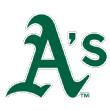My team-by-team draft recaps will appear on Thursday and Friday, but in the meantime, here are some quick thoughts and notes on interesting picks from Tuesday's portion of the draft, comprising Rounds 3-10.
 The Minnesota Twins' Day 1 haul felt a little underwhelming given their draft position -- first overall, plus a Competitive Balance Round A pick after the first, and then the first pick of the second round -- but they swung for the fences to start Day 2. They began the proceedings by taking the top player remaining on my Big Board: Louisiana prep arm Blayne Enlow.
The Minnesota Twins' Day 1 haul felt a little underwhelming given their draft position -- first overall, plus a Competitive Balance Round A pick after the first, and then the first pick of the second round -- but they swung for the fences to start Day 2. They began the proceedings by taking the top player remaining on my Big Board: Louisiana prep arm Blayne Enlow.
Enlow was 14th overall on my Big Board coming into the draft as a projection right-hander who works in the 88-92 mph range now with his fastball in a three-pitch mix that also includes a plus curveball. The ball comes out of his hand easily and he has the delivery and frame to project for bigger velocity and durability down the road. His velocity did slide by the end of the spring, however, which is probably how he ended up being available on Day 2. The Twins also landed another top-100 talent in Puerto Rican shortstop Ricardo De La Torre in the sixth round and they got a toolsy third baseman with some swing-and-miss at the plate in fifth-rounder Andrew Bechtold.
 It seems fitting that the Oakland Athletics took Nick Allen, the 5-foot-8 shortstop from Francis Parker High School outside of San Diego, given their history and reputation as the team willing to take players who don't fit traditional scouting preferences. If Allen were 5-foot-11 he would have been a top-10 pick. He can hit, he can stay at short, and while he's not a runner he has more power than you might guess for a kid his height. We've seen plenty of undersized players become good big leaguers -- Jose Altuve is 5-foot-5, Andrew Benintendi is maybe 5-foot-10 and Alex Bregman is 5-foot-9 (and I might take the under on that last one) but the bias against really short hitters remains. I think the A's got a second first-round-caliber talent here to go with their first pick, Austin Beck.
It seems fitting that the Oakland Athletics took Nick Allen, the 5-foot-8 shortstop from Francis Parker High School outside of San Diego, given their history and reputation as the team willing to take players who don't fit traditional scouting preferences. If Allen were 5-foot-11 he would have been a top-10 pick. He can hit, he can stay at short, and while he's not a runner he has more power than you might guess for a kid his height. We've seen plenty of undersized players become good big leaguers -- Jose Altuve is 5-foot-5, Andrew Benintendi is maybe 5-foot-10 and Alex Bregman is 5-foot-9 (and I might take the under on that last one) but the bias against really short hitters remains. I think the A's got a second first-round-caliber talent here to go with their first pick, Austin Beck.
 The St. Louis Cardinals were the only team this year without a selection on Day 1, the result of their deal to sign Dexter Fowler and the penalty MLB levied against them for hacking the Astros' baseball information system, which also meant they had the smallest bonus pool of any club. They played it fairly straight, taking college players in Rounds 3, 4, 5 and 7-10, including four seniors. Their one high school selection was Zach Jackson, a prep catcher committed to Florida whose best tool is his 55-grade arm. He's a fringy receiver and his swing is straight uphill. I don't know if they were saving money to go over-slot with him or hope to do something creative in Round 11, but it doesn't seem as if these eight players would use their entire bonus pool.
The St. Louis Cardinals were the only team this year without a selection on Day 1, the result of their deal to sign Dexter Fowler and the penalty MLB levied against them for hacking the Astros' baseball information system, which also meant they had the smallest bonus pool of any club. They played it fairly straight, taking college players in Rounds 3, 4, 5 and 7-10, including four seniors. Their one high school selection was Zach Jackson, a prep catcher committed to Florida whose best tool is his 55-grade arm. He's a fringy receiver and his swing is straight uphill. I don't know if they were saving money to go over-slot with him or hope to do something creative in Round 11, but it doesn't seem as if these eight players would use their entire bonus pool.
 The San Diego Padres landed five players from my top 100 with their first five picks, all high school players -- I know you're shocked -- and then followed it up with a real rarity, a high school player from Alaska. Jonny Homza is an infielder and catcher from South Anchorage High School and only the third player ever taken in the top 10 rounds from Seward's Folly. (The others: Brian Montalbo in the fourth round in 2000 and Trajan Langdon in the sixth round in 1994; Langdon signed but Montalbo went to college.) Homza has played third, short and a little bit behind the plate, with pretty good actions at the last position despite his inexperience. The Padres announced him as a third baseman but don't be surprised if he converts to catching in a year, just as the Cardinals did with Carson Kelly.
The San Diego Padres landed five players from my top 100 with their first five picks, all high school players -- I know you're shocked -- and then followed it up with a real rarity, a high school player from Alaska. Jonny Homza is an infielder and catcher from South Anchorage High School and only the third player ever taken in the top 10 rounds from Seward's Folly. (The others: Brian Montalbo in the fourth round in 2000 and Trajan Langdon in the sixth round in 1994; Langdon signed but Montalbo went to college.) Homza has played third, short and a little bit behind the plate, with pretty good actions at the last position despite his inexperience. The Padres announced him as a third baseman but don't be surprised if he converts to catching in a year, just as the Cardinals did with Carson Kelly.
 In the eighth round, the Philadelphia Phillies took a player who was already listed on MLB's own site as a member of their DSL roster, Jhordany Mezquita. They had tried to sign Mezquita, who lives in the Dominican Republic, as an international free agent in the spring, only for MLB to later discover that he had attended high school in the U.S. and thus was draft-eligible. So for the Phillies to sign him, they had to ditch whatever they'd done with him before the season and draft him Tuesday instead.
In the eighth round, the Philadelphia Phillies took a player who was already listed on MLB's own site as a member of their DSL roster, Jhordany Mezquita. They had tried to sign Mezquita, who lives in the Dominican Republic, as an international free agent in the spring, only for MLB to later discover that he had attended high school in the U.S. and thus was draft-eligible. So for the Phillies to sign him, they had to ditch whatever they'd done with him before the season and draft him Tuesday instead.
Best available
From my pre-draft Big Board, here are the best of what's left for the third day of the draft.
30. Kyle Hurt, RHP, Torrey Pines High School, San Diego, California
36. Garrett Mitchell, OF, Orange Lutheran High School, Orange, California
44. Tanner Burns, RHP, Decatur (Alabama) High School
46. Adam Oviedo, SS, Alvarado (Texas) High School
47. Blaine Knight, RHP, Arkansas
62. Tristan Beck, RHP, Stanford
65. Greg Jones, SS, Cary (North Carolina) High School
69. Cordell Dunn, C, Center Hill High School, Olive Branch, Mississippi
75. Brady McConnell, SS, Merritt Island (Florida) HS
79. Hunter Ruth, RHP, Buchholz High School, Gainesville, Florida
Some of these names aren't surprising. Mitchell has been committed to UCLA since 2014 and is a Type 1 diabetic. Knight made comments last week about wanting to return to Arkansas. Beck missed the entire spring because of a stress fracture in his back, and he has had back issues in the past, so teams would have been drafting him off of one year of college performance and hoping he'd return to full health. Ruth had Tommy John surgery in April and is committed to Florida.
The others are all committed to major-conference D1 programs -- Hurt to USC, Burns to Auburn, Oviedo to TCU, Dunn to Texas Tech and McConnell to Florida. Except for Jones, who's committed to UNC-Wilmington and turned 19 in the spring. He'll be draft-eligible as a sophomore, but the competition he'll face in the Colonial Athletic Conference won't help convince teams he's going to hit enough to deserve first-round money.
